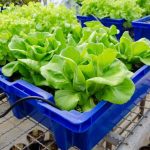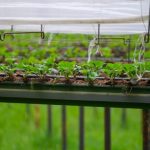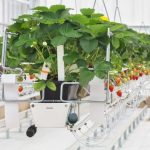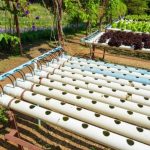Ebb and flow hydroponics is a popular and efficient method of growing plants without soil. With this system, you can cultivate a variety of plants while providing them with essential nutrients and water through periodic flooding and draining cycles. In fact, it is also called the flood and drain method. By using a water-based nutrient solution, you’re ensuring that plants receive everything they need to grow and thrive.
In an ebb and flow system, two main components work together to support plant growth. The water reservoir stores the nutrient-rich solution, while the grow tray houses the plants. During flooding, the water and nutrients flow to the growing area, submerging the roots. Afterwards, the solution drains back into the reservoir, allowing the medium to dry out and the roots to absorb oxygen. This repeating cycle helps your plants develop healthy roots and strong growth.
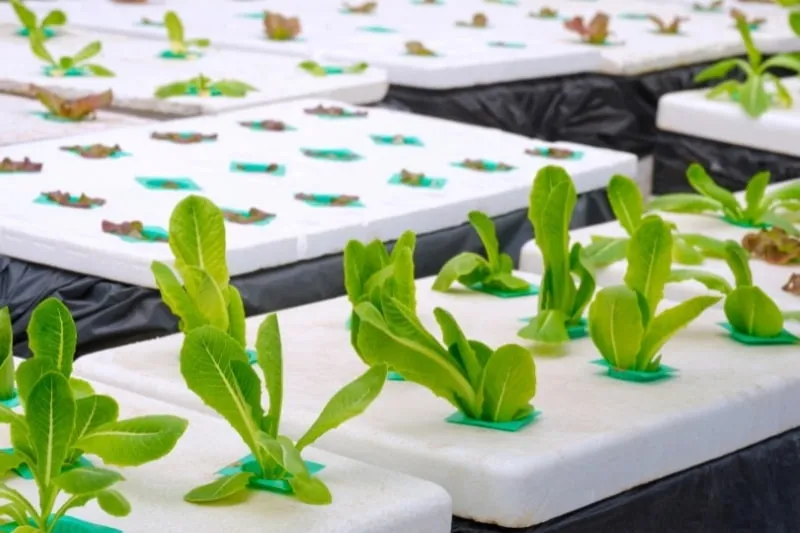
As you explore ebb and flow hydroponics, you’ll benefit from the system’s adaptability and effectiveness in nurturing plant growth. This method can be a great addition to your gardening routine, providing you with abundant harvests and a rewarding experience.
What Is Ebb and Flow Hydroponics?
Ebb and flow hydroponics, also known as flood and drain hydroponics, is a popular and versatile method of soilless plant cultivation. In this system, you provide water, nutrients, and oxygen to the roots of your plants in cycles. These cycles consist of flooding the growing medium with a water-based nutrient solution and then draining the liquid, allowing the medium to dry out.
Hydroponic Ebb and flow systems involve two main stages in their operation: the flooding phase and the draining phase. During the flooding phase, the nutrient solution flows over the plant roots in the growing areas. This allows your plants to absorb the essential nutrients needed for growth. The draining phase provides aeration by removing excess moisture and allowing the growing medium to dry, ensuring the roots get the oxygen they need. This is why there is no need for an air pump with air stones.
Some of the advantages of ebb and flow are that the setup is relatively simple and requires an intermediate level of skill. It is also cost-effective, as the components needed for this system are readily available, making it a suitable choice for both beginners and experienced hydroponic enthusiasts. You can also build an even cheaper ebb and flow setup yourself if you don’t want to go the complete ebb and flow kit route.
When constructing your ebb and flow hydroponics system, it comprises:
- A tray or container for your plants, commonly known as a flood tray
- A reservoir containing the nutrient solution
- A pump to move the nutrient solution between the tray and reservoir
- A timer to control the cycles of flooding and draining
As you utilize this hydroponics method, it’s essential to monitor and maintain the correct nutrient levels, pH balance, and flooding and draining cycles for optimum plant growth.
Related: Learn a little about all the other established hydroponic methods in our extensive guide.
In conclusion, flood and drain hydroponics is an effective and versatile approach to soilless plant cultivation, offering various benefits such as efficient nutrient delivery, oxygenation, and ease of setup. By understanding how this hydroponic system works and properly maintaining it, you can enjoy thriving and healthy plants in your garden.
Origins of Ebb And Flow Hydroponics
You might be curious about when this method came into existence. The roots of hydroponics can be traced back to the famous Hanging Gardens of Babylon, one of the wonders of the ancient world. Although the exact details of their cultivation methods are unclear, it is believed that water was pumped up from the Euphrates River to irrigate the gardens, allowing plants to grow without traditional soil.
However, the ebb and flow technique as a distinct hydroponic method doesn’t have a clear documentation of when it was first created. Nevertheless, we know that hydroponics as a whole has evolved over the centuries, with ebb and flow hydroponics becoming popular in the 20th century.
No specific individual has been credited with the creation of ebb and flow hydroponics, but numerous researchers, scientists, and hobbyists have contributed to its development over the years.
In 1939, Robert Withrow from Purdue University Experiment Station created a sub-irrigation system that was quite practical. He placed tanks beneath shallow containers of plants and used a centrifugal pump to deliver nutrients to them. Gravity allowed the water to drain back into the tanks. Initially referred to as the Withrow method, it is now commonly known as the “ebb and flow” or “ebb and flood” method. This technique proved suitable for larger applications, enhancing the commercial possibilities of hydroponics.
Largely driven by the need for efficient and sustainable methods of cultivation, advancements in technology, and a better understanding of plant physiology, the ebb and flow technique has transformed into the versatile hydroponic system we know today.
How Does Ebb And Flow Hydroponics Work?
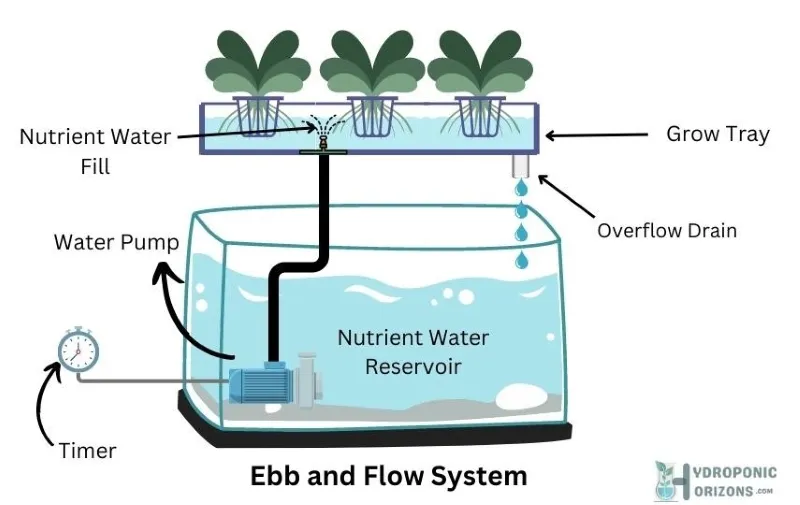
In an Ebb and Flow system, a pump is connected to a timer that determines when the nutrient solution is sent to the growing container. The pump turns on and off based on the timer settings, ensuring a consistent ebb-and-flow action. The solution is delivered through an outlet located at the bottom of the growing container, while an overflow tube regulates the level of the solution directed to the container. This process ensures an adequate and regulated supply of nutrient solution for your plant roots.
Setting up and maintaining an Ebb and Flow hydroponics system is relatively simple compared to some other hydroponic systems, with an intermediate level of skill required. Some key components of the system include a reservoir containing the nutrient solution, the growing container holding the plants and growing medium, a pump, a timer, and the overflow tube. The versatility and low-cost nature of the system allow you to manage various plants and gain experience in hydroponics.
In summary, Ebb and Flow hydroponics is a user-friendly system that delivers a controlled and efficient supply of oxygen, water, and nutrients to your plants’ roots. With proper setup and maintenance, you can grow healthy plants while maximizing their yield.
Types Of Hydroponic Ebb And Flow
There are several types of ebb and flow hydroponic systems that you can consider for your gardening needs, including bucket systems, trough systems, and vertical hydroponics. All are suitable for indoor and outdoor Ebb and Flow hydroponics. Let’s explore each of them briefly.
Hydroponic Ebb and Flow Bucket System: The Dutch bucket system consists of individual buckets filled with a growing medium and connected to a central reservoir via tubing. This allows the nutrient solution to flood the buckets on a timed cycle. Once the flooding phase is complete, the nutrient solution drains back into the reservoir.
This system is easy to set up and maintain, and it’s perfect for maximizing the use of space in your garden, as you can move, add, or remove buckets to suit your grow tent, greenhouse, or patio space. Note, that this system is often categorized separately from traditional flood and drain systems, which we describe below.
Hydroponic Ebb and Flow Trough System: In this simple ebb and flow hydroponic system, plants are arranged in long trays or troughs filled with a growing medium. The troughs are then connected to a main water reservoir that periodically floods the grow space with nutrient solution. After the flooding phase, the solution drains back into the reservoir.
This system is ideal for growing larger crops or long rows of plants, as it provides a uniform distribution of nutrients across the entire grow space. However, you do need a dedicated space that’s large enough to hold a single tray or multiple large trays. Once you set up the system, you can’t move the trays or individual plant pots around. This is the design that most people think of when describing traditional flood and drain hydroponics, so here’s a step-by-step ebb and flow hydroponic system setup that you can build yourself.
Ebb and Flow Vertical Hydroponics: Vertical hydroponics combines the ebb and flow method with a vertical growing setup. Plants are positioned in vertical stacks or towers, and the nutrient-rich water floods their root systems at regular intervals. The water then drains back into the reservoir for reuse. By making use of vertical space, this system can greatly increase the number of plants you can grow in a given area, making it an excellent choice for urban gardeners or those with limited space.
In summary, ebb and flow hydroponics systems provide a versatile and efficient way of growing plants. Depending on your available space and goals, you can choose from the bucket system, trough system, or vertical hydroponics setup to maximize yield and make the most of your gardening efforts.
Components of an Ebb and Flow System
Grow Tray and Growing Medium
In an ebb and flow hydroponics system, you’ll start with a grow tray. This tray, also known as a flood tray, is a shallow container that holds your plants and their growing medium. This medium can vary depending on your preferences, but some common options include:
- Rockwool: A lightweight, porous material that retains moisture well and supports root growth.
- Perlite: A volcanic glass that allows for good aeration and drainage.
- Coco coir: Made from coconut husks, this medium offers good water retention and is a sustainable option.
- Clay pebbles: Also known as hydroton or expanded clay, these pebbles are a popular choice due to their excellent drainage and oxygen availability.
Reservoir and Nutrient Solution
The nutrient solution is the lifeblood of your ebb and flow system, providing your plants with the essential nutrients they need for growth. To store this nutrient-rich water, you’ll need a reservoir. This container sits beneath your grow tray and holds the nutrient solution that will periodically flood the tray, feeding your plants through the process of filling and draining.
It’s essential to maintain the appropriate nutrient levels and pH balance in your reservoir to ensure optimal plant health. You may also want to use an air pump and air stone to keep the solution oxygenated, helping prevent stagnation and root rot. However, this is not necessary as the plant roots are allowed to breathe periodically in between flooding cycles.
Pump and Timer System
To control the flow of water between the reservoir and grow tray, you’ll need a water pump. A submersible pump is a common choice for ebb and flow systems. This pump ensures that your plant roots are consistently flooded and then drained, providing them with the necessary nutrients, oxygen, and water.
It’s crucial to use a timer to automate the flooding and drainage cycles, keeping the system running efficiently and consistently. Timers allow for precision in the watering schedule, ensuring that your plants receive the ideal amount of nutrients and water without being over- or under-watered.
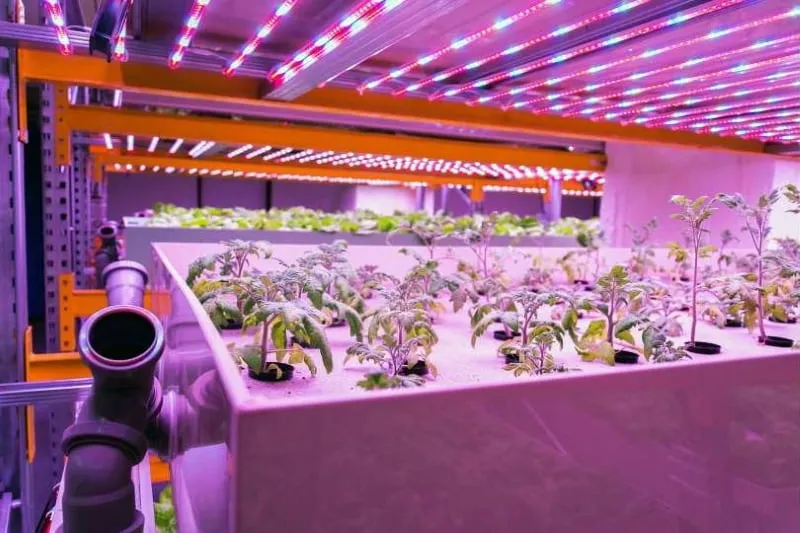
Control and Overflow Mechanisms
To prevent overflows and potential equipment damage, it’s essential to implement control and overflow mechanisms in your ebb and flow system. These include:
- Overflow tube: This tube prevents over-filling by allowing excess water to return to the reservoir.
- Fill and drain tubes: These tubes control the flow of water in and out of the grow tray. The fill tube transports nutrient solution from the reservoir to the tray, while the drain tube carries excess water back to the reservoir.
- Bell siphon: A popular option for bucket-based systems, the bell siphon uses gravity to automatically drain water from your grow tray once it reaches a certain level.
Best Ebb And Flow Hydroponics Plants
Ebb and flow hydroponics is a versatile method that works well with various plants. If you are considering this approach, you might be wondering which plants thrive best with the ebb and flow technique. Below are some excellent options for your ebb and flow hydroponic garden.
Leafy greens are a perfect candidate for ebb and flow hydroponics. They require consistent moisture and grow well in this environment. Examples include lettuce and other salad greens, which benefit from the aeration provided during the flood cycle. You can expect a rapid growth rate when using this method.
Herbs also flourish in ebb and flow systems. Herbs such as sage appreciate the balance of nutrients and oxygen provided by the flood and drain approach. Cultivating a variety of herbs in your ebb and flow hydroponic garden ensures an abundance of fresh and flavorful additions to your meals.
Fruits and vegetables, like tomatoes, cucumbers, and beans, perform exceptionally well in ebb and flow hydroponics. Cherry tomatoes, in particular, are ideal for this method, as they grow quickly and require less support than larger tomatoes. The consistent moisture aids in producing bountiful yields.
Strawberries are another popular choice for ebb and flow hydroponic gardens. The fruits benefit from the nutrient-rich environment, resulting in juicy and flavorful strawberries. They also tend to grow rapidly in this system, allowing you to enjoy a plentiful harvest.
When starting your ebb and flow hydroponic garden, consider nurturing seedlings first. As they are young plants, they require a stable environment to grow strong and healthy. The ebb and flow system provides the necessary nutrients and aeration for seedlings to grow, strengthening their roots.
Ebb And Flow Hydroponics Tips
Here are some tips to help you successfully use flood and drain systems:
Flood And Drain Hydroponic System Timing
- Establish proper flood duration: Determining the right duration for flooding your plants is crucial. Typically, flooding should last 15-30 minutes, depending on the size of your system and plant needs. Experiment to find the best balance between keeping your plants hydrated and avoiding over-saturation.
- Set an interval between floods: The frequency of flooding will depend on plant growth stage, environment, and type of growing medium. Initially, you’ll want to flood 2-4 times daily, adjusting as needed. However, during hotter periods, plants may need more frequent flooding to prevent drying out.
- Monitor and adjust: Keep a close eye on how your plants react to the watering schedule. If you notice yellowing leaves or wilting, this may be a sign to alter the flooding intervals or duration. Adapt your system accordingly to maintain the balance between plant hydration and oxygenation.
- Use a timer: To automate your flood and drain cycle, use a quality hydroponic timer. This will not only ensure consistent watering cycles but will also simplify management.
Following these tips and closely monitoring your flood and drain hydroponic system will help you achieve successful plant growth using ebb and flow techniques. Remember to adjust the system as necessary to cater to your plants’ changing needs, and don’t hesitate to experiment if necessary.
How Long Between Watering Flood And Drain Hydroponics?
The watering interval in a flood and drain system depends on factors such as your plants’ growth stage, the type of growing medium, and the environmental conditions within the grow space. A recommended starting point is to allow 4 to 8 hours between each flooding event to ensure proper oxygenation of your plants’ roots. Monitor your plants closely and adjust the intervals as necessary to maintain healthy growth. Don’t be afraid to experiment with different schedules to find the optimal balance between flooding and draining for your specific hydroponic setup.



